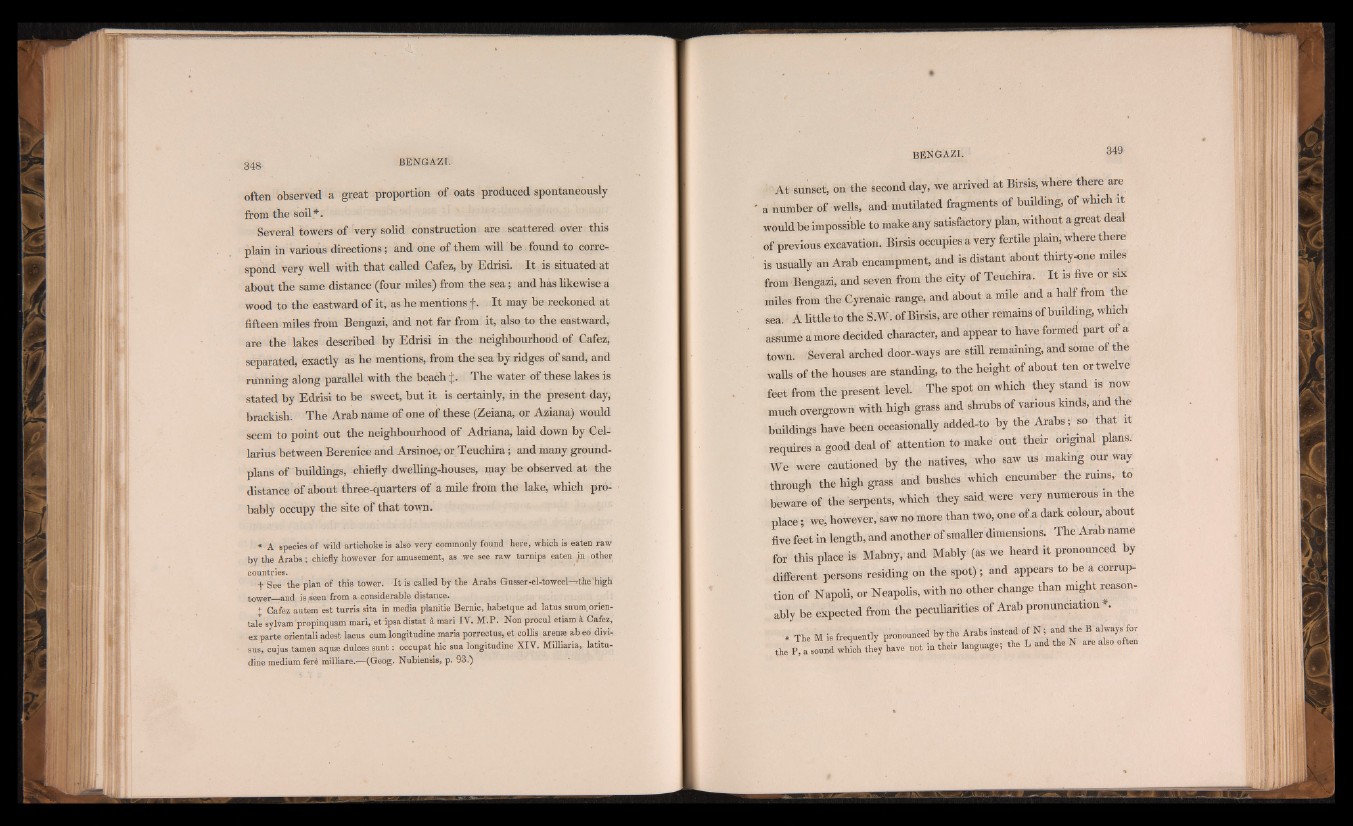
often observed a great proportion of oats produced spontaneously
from the soil*.
Several towers of very solid construction are scattered over this
plain in various directions ; and one of them will be , found to correspond
very well with that called Cafez, by Edrisi. I t is situated at
about the same distance (four miles) from the sea; and has likewise a
wood to the eastward of it, as he mentions j\ I t may be reckoned at
fifteen mdes from Bengazi, and not far from it, also to the .eastward,
are the lakes described by Edrisi in the neighbourhood of Cafez,
separated, exactly as he mentions, from the sea by ridges of sand, and
running along parallel with the beach The water of these lakes is
stated by Edrisi to be sweet, but it is certainly, in the present day,
brackish. The Arab name of one of these (Zeiana, or Aziana) would
seem to point out the neighbourhood of Adriana, laid down by Cel-
larius between Berenice and Arsinoe,’ or Teuchira; and many ground-
plans of buildings, chiefly dwelling-houses, may be observed at the
distance of about three-quarters of a mile from the lake, which probably
occupy the site of that town.
* A species of wild artichoke is also very commonly found here, which is eaten raw
by the Arabs; chiefly however for amusement, as we see raw turnips eaten in other,
countries.
+ See the plan of this tower. I t is called by the Arabs Gusser-el-toweel—the 'high
tower—and is seen from a considerable distance.
+ Cafez autem est turns sita in media planitie Bernic, habetque ad latus suurn orientate
s y l v a m propinquam mari, et ipsadistat hmari IV. M.P. Non procul etiam k Cafez,
ex parte orientali adest lacus cum longitudine maris porrectus, et collis arenae ab eo dm-
sus, cujus tamen aquae dulces sunt: occupat hie sua longitudine XIV. Milliana, latitu-
dirie medium fere inilliare.—(Geog. Nubiensis, p. 93.)
At sunset, on the second day, we arrived at Birsis, where there are
a number of wells, and'mutilated fragments of building, of which it
would be impossible to make any satisfactory plan, without a great deal
of previous excavation. Birsis occupies a very fertile plain, where there
is usually an Arab encampment, and is distant about thirty-one miles
from Bengazi, and seven from the city of Teuchira. I t is five or six
miles from the Cyrenaic range, and about a mile and a half from the
sea. A little to the S.W. of Birsis, are other remains of building, which
assume a more decided character, and appear to have formed part of a
town. Several arched door-ways are still remaining, and some of the
walls of the houses are standing, to the height of about ten or twelve
feet from the present level. The spot on which they stand is now
much overgrown with high grass and shrubs of various kinds, and the
buildings have been occasionally added-to by the Arabs; so that it
requires a good deal of attention to make out their original plans.
We were cautioned by the natives, who saw us making our way
through the high grass and bushes which encumber the ruins, to
beware of the serpents, which they said were very numerous m the
place; we, however, saw no more than two, one of a dark colour, about
five feet in length, and another of smaller dimensions. The Arab name
for this place is- Mahny, and Mably (as we heard it pronounced by
different persons residing on the spot) -, and appears to be a corruption
of Napoli, or Neapolis, with no other change than might reasonably
be expected from the peculiarities of Arab pronunciation *.
* The M is frequently pronounced by the Arabs instead of N ; and fiie